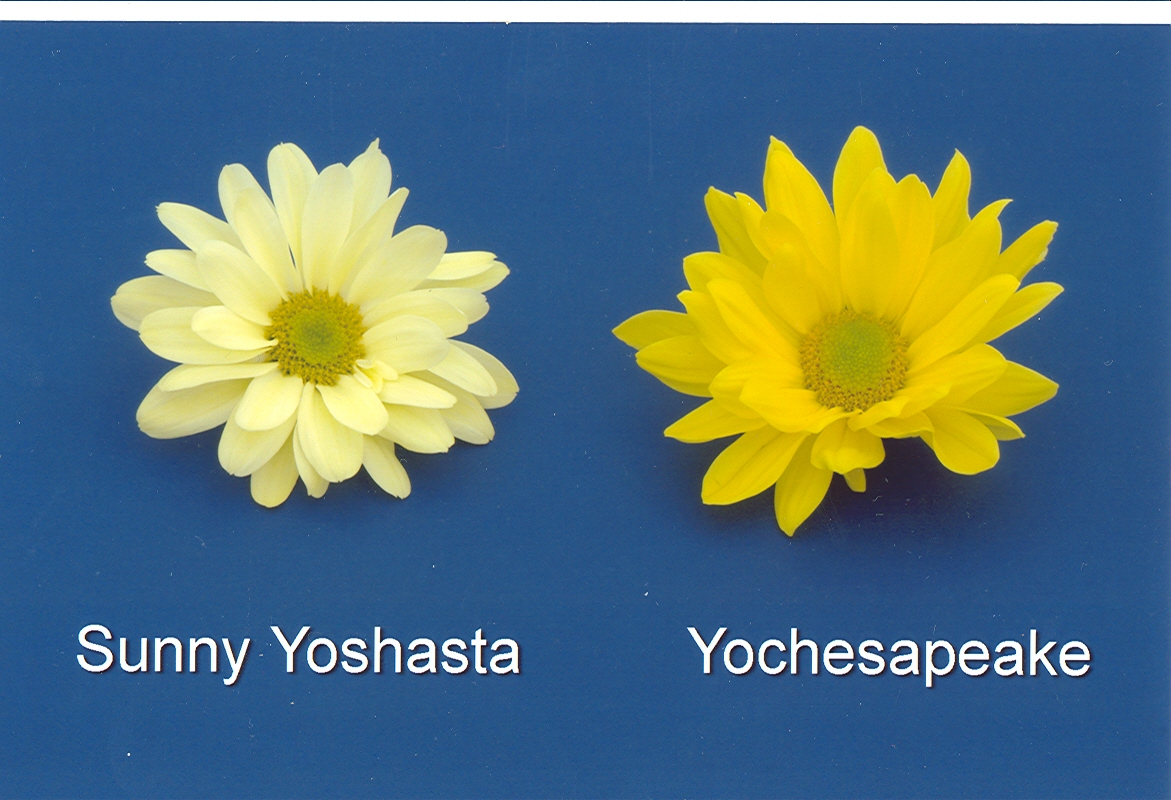Sunny Yoshasta
| Denomination: | 'Sunny Yoshasta' |
|---|---|
| Trade name: | Sunny Shasta |
| Botanical Name: | Chrysanthemum |
| Applicant/Holder: |
Syngenta Crop Protection AG Rosentalstrasse 67 Basel CH-4058 Switzerland |
| Breeder: |
Donald Hammons, Travelers Rest, United States of America |
| Agent in Canada: |
BioFlora Inc. 38723 Fingal Line R.R. #1 St. Thomas, Ontario N5P 3S5 Canada Tel: 519-317-7511 |
| Application Date: | 2002-10-07 |
| Application Number: | 02-3306 |
| Grant of Rights Date: | 2006-12-07 |
| Certificate Number: | 2649 |
| Date rights surrendered: | 2014-10-03 |
Variety Description
Variety used for comparison: 'Yochesapeake'
Summary: 'Sunny Yoshasta' is a spray chrysanthemum variety which has leaves with a longer lower lobe and deeper sinus of the lower lobe than the leaves of 'Yochesapeake'. The flower heads of 'Sunny Yoshasta' are lighter yellow than those of 'Yochesapeake'. The ray florets of 'Sunny Yoshasta' are shorter, with a shorter corolla tube than those of the reference variety.
Description:
'Sunny Yoshasta' is spray type chrysanthemum variety which has plants that are medium in height with a small to medium number of primary lateral shoots. There is no anthocyanin on the stems. The leaves are medium to long in length and medium to broad in width. The base of the leaf is truncate. The lower lobe of the leaf is medium to long in length, and the sinus deep. The margins of the sinus between the lateral lobes are converging.
'Sunny Yoshasta' has semi-double, daisy type flower heads, which are light yellow in colour. The flower heads are small to medium in diameter and there are no bracts among the florets. The ray florets are straight and short to medium in length, with a short corolla tube. In cross section the ray floret is concave and the tip of the floret is rounded, emarginate or dentate. Before anther dehiscence the disc of 'Sunny Yoshasta' is green. At dehiscence the disc is yellow. The disc is small to medium in diameter, with tubular florets which are massed at the centre of the flower head.
Origin & Breeding History: 'Sunny Yoshasta' is a naturally occurring mutation, discovered by the breeder, an employee of Northside Greenhouses, Inc. of South Carolina, U.S.A. The variety was discovered and selected as a single flowering plant within a population of the Chrysanthemum variety 'Yoshasta' in February 1999, in Travelers Rest, South Carolina. The selection of the plant, which became the variety 'Sunny Yoshasta', was based on its desirable inflorescence form and floret colour. Asexual reproduction of 'Sunny Yoshasta' was first conducted in a controlled environment in Travelers Rest, South Carolina, U.S.A.
Tests & Trials: Tests and trials for 'Sunny Yoshasta' were conducted at Yoder Canada Ltd., Leamington, Ontario, in the fall of 2005. Flowering trials were performed under greenhouse conditions similar to those used in commercial production. On August 8, 2005, unrooted cuttings of the candidate and reference varieties were directly stuck into 15cm pots, with 4 cuttings per pot and 10 pots per variety. Plants were pinched once prior to short day treatment. All plants had the centre bud removed. Pots were spaced 12 inches apart. Observations and measurements were taken from 10 plants of each variety on November 3, 2005. All colour measurements were made using the RHS Colour Chart 2001.
Comparison tables for 'Sunny Yoshasta' with reference variety 'Yochesapeake'
Length of lower lobe of leaf (cm)
| 'Sunny Yoshasta' | 'Yochesapeake' | |
|---|---|---|
| mean | 3.4 | 2.8 |
| std. deviation | 0.72 | 0.67 |
Depth of sinus of lower leaf lobe (cm)
| 'Sunny Yoshasta' | 'Yochesapeake' | |
|---|---|---|
| mean | 2.1 | 1.4 |
| std. deviation | 0.49 | 0.36 |
Length of ray floret (cm)
| 'Sunny Yoshasta' | 'Yochesapeake' | |
|---|---|---|
| mean | 3.2 | 3.9 |
| std. deviation | 0.11 | 0.19 |
Length of corolla tube (cm)
| 'Sunny Yoshasta' | 'Yochesapeake' | |
|---|---|---|
| mean | 0.4 | 0.7 |
| std. deviation | 0.08 | 0.12 |
Colour of ray floret (RHS)
| 'Sunny Yoshasta' | 'Yochesapeake' | |
|---|---|---|
| upper surface | 2D-3D | 5B |
| lower surface | close to 155B | 5C |
Click on image for larger view

Chrysanthemum: 'Sunny Yoshasta' (left) with reference variety 'Yochesapeake' (right)
- Date modified: